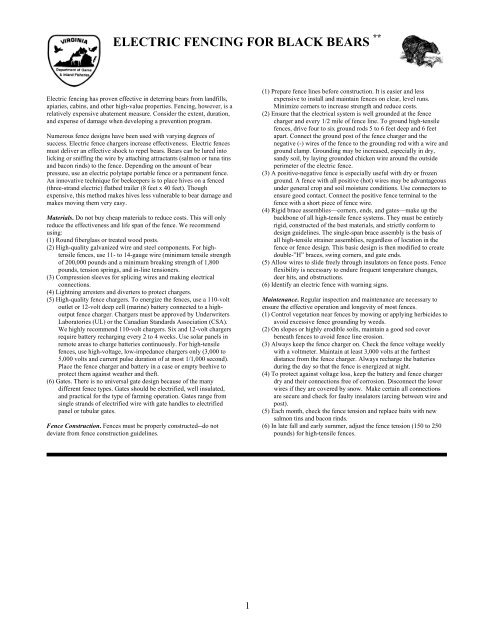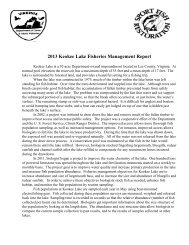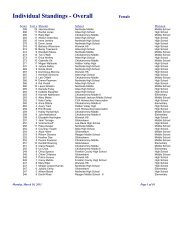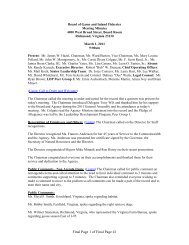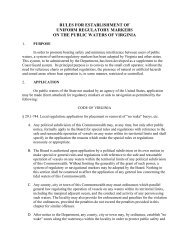ELECTRIC FENCING FOR BLACK BEARS
ELECTRIC FENCING FOR BLACK BEARS
ELECTRIC FENCING FOR BLACK BEARS
Create successful ePaper yourself
Turn your PDF publications into a flip-book with our unique Google optimized e-Paper software.
<strong>ELECTRIC</strong> <strong>FENCING</strong> <strong>FOR</strong> <strong>BLACK</strong> <strong>BEARS</strong> **<br />
Electric fencing has proven effective in deterring bears from landfills,<br />
apiaries, cabins, and other high-value properties. Fencing, however, is a<br />
relatively expensive abatement measure. Consider the extent, duration,<br />
and expense of damage when developing a prevention program.<br />
Numerous fence designs have been used with varying degrees of<br />
success. Electric fence chargers increase effectiveness. Electric fences<br />
must deliver an effective shock to repel bears. Bears can be lured into<br />
licking or sniffing the wire by attaching attractants (salmon or tuna tins<br />
and bacon rinds) to the fence. Depending on the amount of bear<br />
pressure, use an electric polytape portable fence or a permanent fence.<br />
An innovative technique for beekeepers is to place hives on a fenced<br />
(three-strand electric) flatbed trailer (8 feet x 40 feet). Though<br />
expensive, this method makes hives less vulnerable to bear damage and<br />
makes moving them very easy.<br />
Materials. Do not buy cheap materials to reduce costs. This will only<br />
reduce the effectiveness and life span of the fence. We recommend<br />
using:<br />
(1) Round fiberglass or treated wood posts.<br />
(2) High-quality galvanized wire and steel components. For hightensile<br />
fences, use 11- to 14-gauge wire (minimum tensile strength<br />
of 200,000 pounds and a minimum breaking strength of 1,800<br />
pounds, tension springs, and in-line tensioners.<br />
(3) Compression sleeves for splicing wires and making electrical<br />
connections.<br />
(4) Lightning arresters and diverters to protect chargers.<br />
(5) High-quality fence chargers. To energize the fences, use a 110-volt<br />
outlet or 12-volt deep cell (marine) battery connected to a highoutput<br />
fence charger. Chargers must be approved by Underwriters<br />
Laboratories (UL) or the Canadian Standards Association (CSA).<br />
We highly recommend 110-volt chargers. Six and 12-volt chargers<br />
require battery recharging every 2 to 4 weeks. Use solar panels in<br />
remote areas to charge batteries continuously. For high-tensile<br />
fences, use high-voltage, low-impedance chargers only (3,000 to<br />
5,000 volts and current pulse duration of at most 1/1,000 second).<br />
Place the fence charger and battery in a case or empty beehive to<br />
protect them against weather and theft.<br />
(6) Gates. There is no universal gate design because of the many<br />
different fence types. Gates should be electrified, well insulated,<br />
and practical for the type of farming operation. Gates range from<br />
single strands of electrified wire with gate handles to electrified<br />
panel or tubular gates.<br />
Fence Construction. Fences must be properly constructed--do not<br />
deviate from fence construction guidelines.<br />
1<br />
(1) Prepare fence lines before construction. It is easier and less<br />
expensive to install and maintain fences on clear, level runs.<br />
Minimize corners to increase strength and reduce costs.<br />
(2) Ensure that the electrical system is well grounded at the fence<br />
charger and every 1/2 mile of fence line. To ground high-tensile<br />
fences, drive four to six ground rods 5 to 6 feet deep and 6 feet<br />
apart. Connect the ground post of the fence charger and the<br />
negative (-) wires of the fence to the grounding rod with a wire and<br />
ground clamp. Grounding may be increased, especially in dry,<br />
sandy soil, by laying grounded chicken wire around the outside<br />
perimeter of the electric fence.<br />
(3) A positive-negative fence is especially useful with dry or frozen<br />
ground. A fence with all positive (hot) wires may be advantageous<br />
under general crop and soil moisture conditions. Use connectors to<br />
ensure good contact. Connect the positive fence terminal to the<br />
fence with a short piece of fence wire.<br />
(4) Rigid brace assemblies—corners, ends, and gates—make up the<br />
backbone of all high-tensile fence systems. They must be entirely<br />
rigid, constructed of the best materials, and strictly conform to<br />
design guidelines. The single-span brace assembly is the basis of<br />
all high-tensile strainer assemblies, regardless of location in the<br />
fence or fence design. This basic design is then modified to create<br />
double-”H” braces, swing corners, and gate ends.<br />
(5) Allow wires to slide freely through insulators on fence posts. Fence<br />
flexibility is necessary to endure frequent temperature changes,<br />
deer hits, and obstructions.<br />
(6) Identify an electric fence with warning signs.<br />
Maintenance. Regular inspection and maintenance are necessary to<br />
ensure the effective operation and longevity of most fences.<br />
(1) Control vegetation near fences by mowing or applying herbicides to<br />
avoid excessive fence grounding by weeds.<br />
(2) On slopes or highly erodible soils, maintain a good sod cover<br />
beneath fences to avoid fence line erosion.<br />
(3) Always keep the fence charger on. Check the fence voltage weekly<br />
with a voltmeter. Maintain at least 3,000 volts at the furthest<br />
distance from the fence charger. Always recharge the batteries<br />
during the day so that the fence is energized at night.<br />
(4) To protect against voltage loss, keep the battery and fence charger<br />
dry and their connections free of corrosion. Disconnect the lower<br />
wires if they are covered by snow. Make certain all connections<br />
are secure and check for faulty insulators (arcing between wire and<br />
post).<br />
(5) Each month, check the fence tension and replace baits with new<br />
salmon tins and bacon rinds.<br />
(6) In late fall and early summer, adjust the fence tension (150 to 250<br />
pounds) for high-tensile fences.
2<br />
Polytape portable electric fence. One person can easily and quickly<br />
install this fence. It is economical and dependable for low to moderate<br />
bear pressures. The fence consists of four strands of electric polytape<br />
that are attached to posts with insulators. Various forms of polytape or<br />
polywire, such as Visible Grazing Systems® (VGS), Baygard®, and<br />
Turbo-tape® are very strong and portable. The cost per fence (33 x 33<br />
feet) is about $200. (~ $1.50/linear ft)<br />
1 200-yard roll of polytape<br />
12 4-foot fence rods (5/16-inch diameter)<br />
48 Insulators or clips<br />
4 Gate handles<br />
1 12-volt fence charger<br />
1 12-volt deep cycle battery<br />
Herbicides<br />
To install: Drive in four corner posts 1 foot deep and attach a guy wire. Clip vegetation in a 15-inch-wide strip under the fence and apply herbicide. Attach<br />
insulators on the inside of corner posts and stretch the electro-plastic wire from the four posts at intervals of 6, 16, 26, and 36 inches from ground level.<br />
Hand tighten the polytape and join the ends with four square knots. Drive in the remaining posts at 12-foot intervals, attach insulators (on the outside of<br />
line posts), and insert polytape.<br />
Woven-wire permanent electric fence. This fence, best used under high<br />
bear pressure, is the most durable and expensive barrier. Two people<br />
can install it in 8 hours. The fence consists of heavy, 5-foot woven<br />
wire, supported by wooden posts, ringed by two additional electrified<br />
wires. Cost per fence (33 x 33 feet) is about $400. (~ $3.00/linear ft)<br />
1 50-yard roll of 6-inch square mesh, 5-foot woven wire<br />
1 150-yard roll of high-tensile (14-gauge) smooth wire<br />
24 8-foot treated wooden posts<br />
40 Porcelain strain-insulators (screw-in types)<br />
1 2-pound box of 1 1/2-inch fence staples<br />
6 gate handles<br />
1 12-volt fence charger<br />
1 12-volt deep cycle battery<br />
Herbicides<br />
To install: Set posts 6 to 12 feet apart in 2-foot-deep holes. Align four corner posts at 5 o angles from the vertical. Brace corner and gate posts from the<br />
inside with posts set at 45 o angles. Clip a 15-inch-wide strip clear of vegetation under the fence and apply herbicide. Place one length of welded wire<br />
vertically into position and staple the end to a corner post. Pull the entire length of wire taut with a vehicle and staple the welded wire to the line posts.<br />
Continue until all sides, except the gate opening, are fenced. Fasten two strands of high-tensile wire to insulators positioned 5 inches away from the<br />
welded wire, at intervals of 6 and 56 inches above ground level. For a 12-foot gate opening, attach three strands of high-tensile wire to insulators on the<br />
gateposts. Space the wires at intervals of 6, 36, and 56 inches above ground level. Connect them to the two strands previously strung around the fence.<br />
These wires will be connected to the positive fence charger terminal. Attach three more wires to gatepost insulators at intervals of 20, 48, and 64 inches<br />
above ground level. These three wires will be connected together and to the ground rod. Fit insulated gate handles to the free ends of all six gate wires.
High-tensile permanent electric fence. High-tensile fencing can<br />
provide year-round protection. Many designs are available to meet<br />
specific needs. All require strict adherence to construction guidelines<br />
concerning rigid corner assemblies and fence configurations. Frequent<br />
inspection and maintenance are required. High-tensile fences are<br />
expected to last 20 to 30 years. Vertical fences are effective at<br />
protecting large areas from moderate to high pressures. There are a<br />
wide variety of fence materials, wire spacings, and specific designs you<br />
can use. Barbed wire (3-4 inches between barbs) will help provide<br />
more electric contact through the insulating fur than will smooth wire.<br />
Costs, excluding labor, range from $0.75 to $1.50 per linear foot.<br />
.<br />
3<br />
To install: Install rigid corner assemblies where necessary. String a 12<br />
1/2-gauge high-tensile wire around the corner assemblies and apply<br />
light tension. Set 8-foot line posts along. Attach a wire to insulators at<br />
4-6 inches above ground level and apply 150 to 250 pounds of tension.<br />
Attach the remaining wires to insulators at a 10-inch spacing and apply<br />
150 to 250 pounds of tension. Connect the second, fourth, fifth, and<br />
seventh wires from the top, to the positive (+) post of a well-grounded,<br />
low-impedance fence charger. Connect the top, third, and sixth wires<br />
directly to ground. The top wire should be negative for lightning<br />
protection. Clear and maintain a 6- to 12-foot open area outside the<br />
fence. Maintenance includes weekly fence inspection and voltage<br />
checks.<br />
** Adapted from Hygnstrom, S. E., R. M. Timm, and G. E. Larson. 1994. Prevention and control of wildlife damage. University of<br />
Nebraska Cooperative Extension Service, US Department of Agriculture, Animal and Plant Health Inspection Service.


